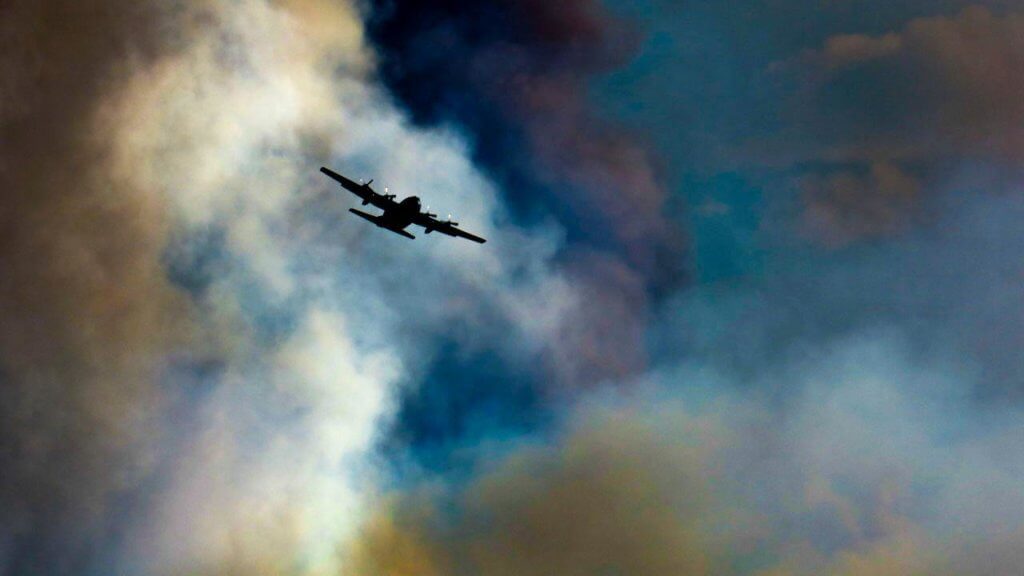
A reflection on aviation use and the work of IAWF
By Alen Slijepcevic
As the IAWF Board has started to publish issues papers, one of which is about fire suppression, I would like to reflect on one aspect that is becoming both an opportunity and a challenge for fire agencies globally, and that is the increased use of aircraft. Over the last couple of decades, the use of aircraft has significantly increased not only in numbers, but also in size, especially fixed wing aircraft. We have seen an introduction of Boeing 747s and more recently 737s. With the increase in use we are seeing increase of ineffective/inefficient use of aircraft in fire suppression.
I would like to state that I am a great believer in the use of aircraft for fire suppression. Aircraft are an extremely valuable tool that, when used appropriately, significantly add to the overall success of firefighting. For example, their great use and benefit is in an initial attack phase of firefighting to keep fires small while ground crews are coming, supporting backburning operations, and in asset protection with targeted drops around values at risk if conditions are favorable. However … and there is always at least one “however.”
Before I further discuss the use of firefighting aircraft, it is important to understand the context under which they are operating. Since the late 1990s, we have started to encounter the combined effect of over-reliance on fire suppression, lack of healthy fire regimes across the landscape, and also the impacts of climate change. What does that mean to fuels and fires? Globally, there is more available fuel (vegetation) because of a fire suppression (not allowing natural fires to burn through the landscape), and also at the same time those fuels are becoming drier and therefore more flammable. Increasingly the fire management community experiences fire severity that is impossible to extinguish until weather conditions improve. Fires are burning hotter than ever, even under reasonably mild fire danger conditions. Most fire danger systems around the globe were designed before the end of eighties or significantly earlier. The disconnect we are experiencing on the ground and the signals we receive from fire danger systems call into question their appropriateness for the conditions we now face.
Now, back to the aircraft. The threshold when aircraft stops being effective is normally described as when a fire burns at intensities of 4,000 kW/m or more. In the extreme, aircraft will have some effect on fire behavior up to fire intensity of 10,000 kW/m. Most of forest fires around the world under moderate weather conditions will exceed threshold conditions even if atmospheric conditions are stable.
However, around the globe we are still using aircraft under conditions where we know they will be ineffective. Good fire managers know this. There are countless images seen on TV showing aircraft dropping on fires with pyrocumulonimbus (PyroCB) columns more than 10,000 m up in the air. Images like this perpetuate the fallacy that aircraft can be effective under these conditions. Politicians, media and communities have been “educated” through these images. And if aircraft are not present, regardless of effectiveness, fire managers are questioned on their effort. Research in the US supports that there is no correlation between aircraft usage and fire danger; however, there is a strong correlation in the use of aircraft within the rotation of some Incident Management Teams. The implication is that some IMTs either buckle under pressure and excessively use aircraft as a political/public risk management tool or use aircraft to highlight the importance of their fire (“my fire is more important than other fires” syndrome).
The same situation is replicated in other parts of the world. As climate change accelerates the fire weather and alters the fire regimes, the costs of fire suppression have increased significantly. A good portion of those costs are now spent on aircraft and associated suppressants and retardants. And if nothing changes, those costs will keep rising. But we need to ask ourselves whether these costs are justified and are we returning value to the public. The question is how we change this trend.
So how do we do that? It will take a concentrated effort by researchers, fire managers and organizations such as the IAWF to turn things around and re-educate the public, the politicians and the media. Firstly, we need to become better in collecting data on effectiveness of fire suppression in different conditions (weather, terrain, vegetation type and similar). Secondly, we use that info to build decision support tools that will, as a part of a metrics, consider effectiveness of different suppression strategies and resources as well as the economics of our decisions. The role of IAWF is to facilitate sharing of the existing and new knowledge but also in connecting researchers and operational people. So we will continue to do that through our Magazine, the International Journal of Wildland Fire, and through our conferences.
On reflection there is another story that we rarely hear about and that is the story about the true heroes of firefighting – machinery operators (dozer, excavators and graders), as well as our crews that conduct either direct suppression or backburning operations. Without them, there would be no success. So, thank you all for doing such an amazing job. I know that is so rewarding on a personal level and camaraderie is second to none. However, when it comes to public opinion, it is still a thankless job.
For More Information
Stonesifer Crystal S., Calkin David E., Thompson Matthew P., Stockmann Keith D. (2016) Fighting fire in the heat of the day: an analysis of operational and environmental conditions of use for large airtankers in United States fire suppression. International Journal of Wildland Fire 25, 520-533. https://doi.org/10.1071/WF15149
